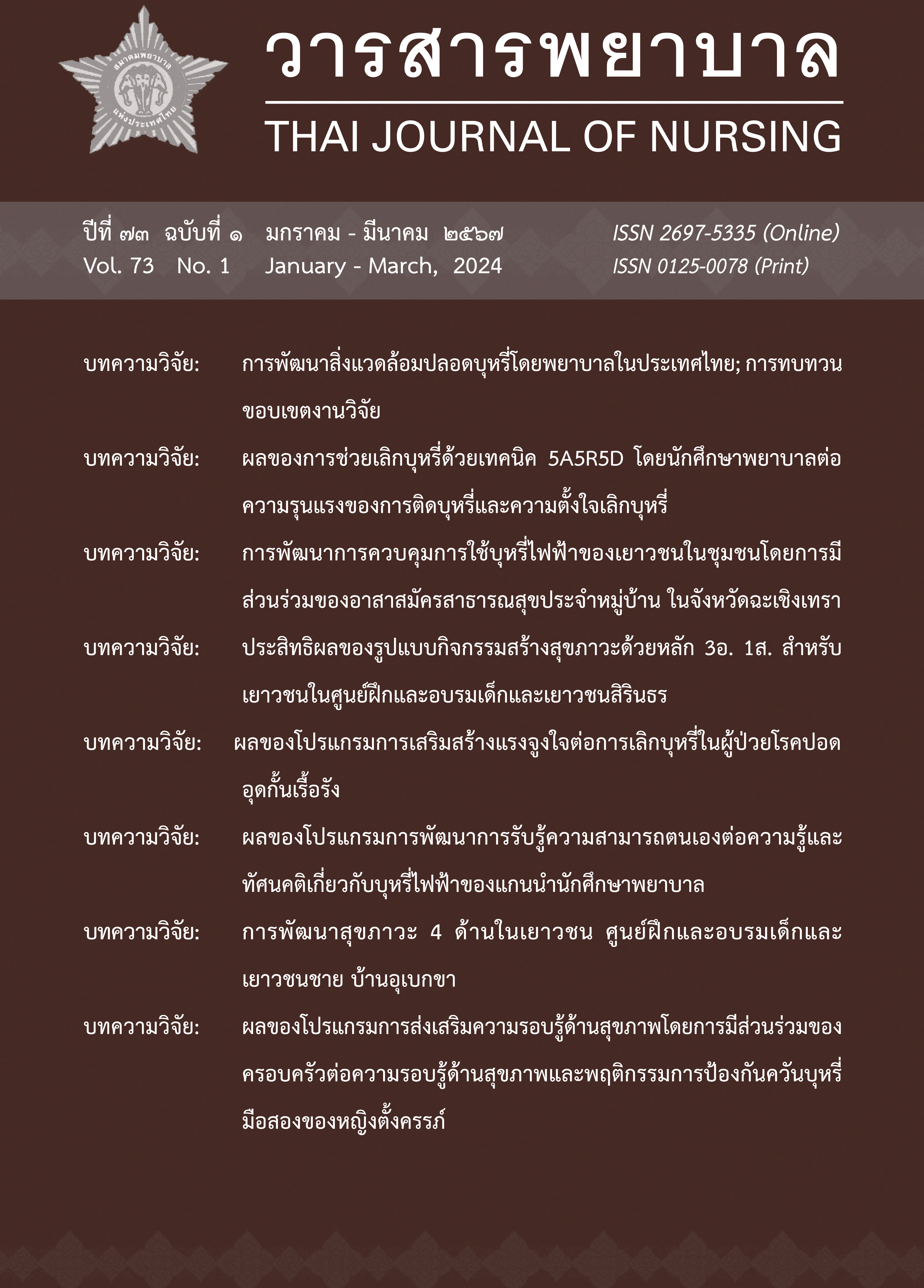The effects of a health literacy enhancement program with family’s participation on health literacy and secondhand smoke preventive behaviors of pregnant women
Main Article Content
Abstract
The purpose of this quasi-experimental research was to study the effects of a health literacy enhancement program with family’s participation on the health literacy and secondhand smoke preventive behaviors of pregnant women. The sample of 34 pregnant women who attended the antenatal clinic at Krathum Baen Hospital, was selected by purposive sampling, and they were divided into the experimental (17 persons) and the comparison (17 persons) groups. The research instruments included: 1) a health literacy enhancement program with family’s participation, the duration of which was 8 weeks. The activities comprised: (1) giving knowledge, (2) developing information access skills, (3) developing communication skills, (4) developing decision-making skills, (5) developing self -management skills, and (6) developing media literacy skills; and 2) questionnaires on knowledge and second-hand smoke preventive behaviors, the reliability of which were 0.93 and 0.93 respectively. Data were analyzed by descriptive statistics and t-test. The result revealed as follows. After attending the program, both health literacy and secondhand smoke preventive behaviors of the experimental group were significantly higher than before attending the program, and higher than those of the comparison group (p < .001).
Article Details

This work is licensed under a Creative Commons Attribution-NonCommercial-NoDerivatives 4.0 International License.
References
ขวัญตา สุธรรม. (2561). การป้องกันตนเองจากควันบุหรี่มือสองของนักเรียนมัธยมศึกษาตอนต้น จังหวัดราชบุรี (วิทยานิพนธ์ปริญญามหาบัณฑิต ไม่ได้ตีพิมพ์). มหาวิทยาลัยธรรมศาสตร์, ปทุมธานี.
ไพฑูรย์ สอนทน และ อัมพร สอนทน. (2561). การได้รับควันบุหรี่มือสองในบ้านระหว่างตั้งครรภ์กับน้ำหนักทารกแรกเกิดน้ำหนักน้อย. วารสารสาธารณสุข, 51(2), 92-100.
มูลนิธิรณรงค์เพื่อการไม่สูบบุหรี่. (2562). อันตรายจากควันบุหรี่ แม้ไม่ได้สูบเองก็ส่งผลเสียทั้งต่อคุณแม่และลูกในครรภ์. http://www.smokefreezone.or.th/idea_page/289/.html
รจนารถ ชูใจ, ชลธิชา บุญศิริ, และกมลพร แพทย์ชีพ. (2564). ผลของโปรแกรมการส่งเสริมความรอบรู้ด้านสุขภาพในการป้องกันโรคโควิด 19 ต่อความรอบรู้ด้านสุขภาพและพฤติกรรมการป้องกันโรคโควิด 19 ของอาสาสมัครสาธารณสุขประจำหมู่บ้าน ตำบลดอนตะโก อำเภอเมือง จังหวัดราชบุรี. วารสารเครือข่ายวิทยาลัยพยาบาลและการสาธารณสุขภาคใต้, 8(1), 250-262.
ศิริวรรณ พิทยรังสฤษฎ์ และ ปวีณา ปั้นกระจ่าง. (2561). รายงานสถิติการบริโภคยาสูบของประเทศไทย พ.ศ.2561. มหาวิทยาลัยมหิดล.
สมบัติ ทามะสุข, จริยาวัตร คมพยัคฆ์, และชฎาภา ประเสริฐทรง. (2563). ควันบุหรี่มือสองกับพฤติกรรมการป้องกันควันบุหรี่มือสองของผู้หญิงที่มีสามีสูบบุหรี่. วารสารเกษมบัณฑิต, 21(2), 30-39.
สุรีย์ลักษณ์ สุจริตพงศ์. (2560). ผลกระทบของการเสพสารเสพติดระหว่างตั้งครรภ์. คณะแพทยศาสตร์ศิริราชพยาบาล มหาวิทยาลัยมหิดล
อรณิชา โพธิ์หมื่นทิพย์. (2564). ประสิทธิผลของโปรแกรมความรอบรู้ด้านสุขภาพเพื่อป้องกันโรคอ้วนของนักเรียนมัธยมศึกษาตอนต้น ในอำเภอเมือง จังหวัดนครราชสีมา. https://www.mnrh.go.th/pdf_file_
academic/academic_25640818-01.pdf
Cohen, J. (1988). Statistical power analysis for the behavioral sciences. Lawrence Erlbaum Associates.
Mackie, B. R., Mitchell, M., & Marshall, A. P. (2019). Patient and family members’ perceptions of family participation in care on acute care wards. Scandinavian Journal of Caring Sciences, 33(2), 359-370.
Abu Elmawaheb, N., Abd El-Rady, S., Mustafa, M., Ahmed, N. (2014). Effect of risk factors and habits on preterm labor at women’s health hospital. Assiut Scientific Nursing Journal, 2(4), 36-47. http://doi:10.21608/ASNJ.2014.58651
Nutbeam, D. (2008). The evolving concept of health literacy. Social Science & Medicine, 67(12), 2072-2078.
Sebern, M. (2005). Shared care elder and family member skills used to manage burden. Journal of Advanced Nursing, 52(2), 170-179.
Wada, K., Ueyama, J., Konishi, K., Goto, Y., Koda, S., Mizuta, F., Tamura, T., Watanabe, K., Ando, K., Kondo, T., & Nagata, C. (2020). Associations between exposure to tobacco smoke and behavioral problems in preschool Japanese children. Journal of Environmental and Public Health, Article 7591263. http://doi:10.1155/2020/7591263


